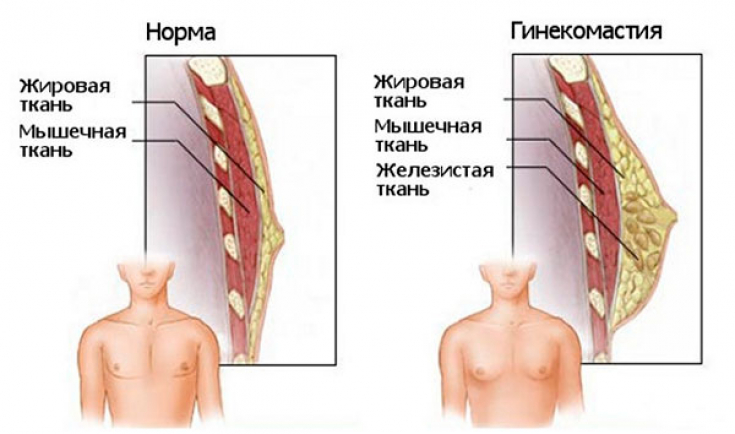Gynecomastia is a benign enlargement of the male breast (usually bilateral, but sometimes unilateral) resulting from an overgrowth of the glandular component of the mammary gland. Gynecomastia should be distinguished from pseudogynecomastia (lipomastia), which is characterized by the deposition of fat without proliferation of glands.
This condition can bring significant discomfort to a man, cause sexual dysfunction and, as a result, depression. About what are the methods of treating gynecomastiaand read on estet-portl.com in this article.
Subtleties of diagnosis and treatment of gynecomastia
When gynecomastia is detected – the doctor's task is to find out whether breast enlargement is benign or indicates a serious health hazard. Thus, for diagnosis, it is necessary to find out how long the patient began to worry about breast enlargement, whether it is accompanied by changes in the size of the nipples and / or discharge from them. It is important to clarify whether the patient had mumps, testicular trauma, hypogonadism, infertility, sexual dysfunction, and whether gynecomastia was observed in men in his family.
Physical examination should include:
• careful examination of the mammary glands, determination of their size and consistency;
• evaluation of nipple discharge;
• detection of axillary lymphadenopathy;
• testicular examination;
• determination of signs of feminization.
As a general rule, no further diagnosis or treatment is required for physiological gynecomastia.
More detailed diagnostics are necessary if the breast size is more than 5 cm (macromastia) and in the presence of seals that have signs of malignancy.
Gynecomastia syndrome: hormonal disorders in men
Pathophysiology of changes in gynecomastia
Gynecomastia occurs as a result of a shift in the estrogen-androgen balance in favor of estrogens, or due to an increased sensitivity of the breast to normal levels of circulating estrogen.
Estrogens cause hyperplasia of the ductal epithelium, elongation and branching of the ducts, proliferation of periductal fibroblasts, and increased vascularization.
Gynecomastia can be physiological or pathological. Physiological gynecomastia is observed in newborns, adolescents and the elderly.
The increase in estrogen production and/or action may occur at the level of the testicles or in the periphery. May be caused by testicular tumors or ectopic production of human chorionic gonadotropin, as occurs in lung, kidney, gastrointestinal, and extragonadal germ cell tumors.

Gynecomastia can also be associated with elevated substrate levels or increased aromatase activity, as in chronic liver disease, malnutrition, hyperthyroidism, adrenal tumors, and familial gynecomastia.
Read the latest articles in Telegram!
The main treatments for gynecomastia
In most patients, pubertal gynecomastia resolves spontaneously within a few weeks to 3 years.
Pharmacological agents used to treat idiopathic and secondary gynecomastia include:
• clomiphene;
• tamoxifen;
• danazol (less commonly used).
Among the surgical treatments for gynecomastia:
• reduction mammoplasty: can be performed in case of macromastia, long-standing gynecomastia or unsuccessful medical therapy, as well as for cosmetic reasons;
• more extensive plastic surgery: can be a solution in cases of severe gynecomastia or excessive sagging of breast tissue after weight loss;
• endoscopic subcutaneous mastectomy without excision of the skin.
Before prescribing cosmetic treatment, it is important to treat the underlying cause of gynecomastia, since it is not just a surge of hormones that can cause an increase in the mammary glands in men, but malignant neoplasms.
Read also: Non-female breast problems: Gynecomastia in men







Add a comment